 2
Issue 2
2
Issue 2
‘Post-something’ – actions and voices of a generation under 35: the Lisbon Architecture Triennale 2013
The 2013 Lisbon Architecture Triennale, Close, Closer, addresses the challenges and opportunities facing Europe as a result of the recent economic crisis.
Close, Closer, the 3rd edition of Lisbon Architecture Triennale, is hosted by a city facing harsh, contrasting realities. Lisbon is a cosmopolitan and luminous Atlantic city proud of its history, as well as an attractive destination boosted by international ‘best-of’ urban nominations. It vibrates in multiplicity as the international hype, along with a moderate living cost, attracts all sorts of visitors, from luxury cruises to low-cost flights. Lisbon has a buzz, and in September 2013 this buzz is heightened by the Triennale, during which events leaked from traditional cultural venues into public and more ‘alternative’ spaces.
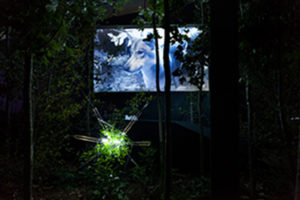
And Nowhere a Shadow, Cohen Van Balen, at Future Perfect exhibition. (Photo (c) Luke Hayes)
The lively atmosphere of the centre masks the burst of the economic bubble and its devastating effects in the country at all levels. To understand the moment in which Portuguese architecture exists we must dig deeper into its present: Portugal is in recession. Assaulted by the European financial crisis, the Portuguese government, along with the International Monetary Fund and the European Bank, declared economic austerity in the country. Economic investment and consumption rates have dropped almost to stagnation. The harsh economic conditions affect both architecture and culture. Architecture and building depend on investment, while culture tends to depend on the State and on private donations.

Casa do Vapor with children, Crisis Buster Competition Project. (Photo (c) Ines Moreira)
From real estate investors and building companies facing bankruptcy, to frozen public competitions, commissions or subventions, to private national and foreign investments heading to other places, all the main players have withdrawn from Portugal in 2013. Architectural building design, along with its cultural dissemination, has come to a deadlock even for Pritzker Award-winning architects Siza Vieira and Souto de Moura. Like in other southern-European countries, such as Spain or Greece, in the past several years hundreds of offices have closed, many architects have emigrated, and unemployment rates are higher than ever before. One further fact: the country has one of the highest ratios of architects per inhabitant in the world, 1.6 architects per 1000 inhabitants. Social, political and economic conditions have been the main anxieties of architects in the last years: some have found new markets, such as Angola, Mozambique, or Argelia, and some revisit their skills to understand the very notion of what trends in architecture may come next. Close, Closer addresses these ideas.
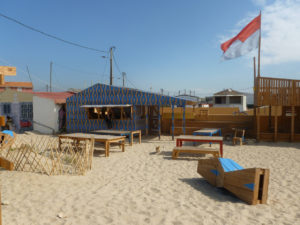
Casa do Vapor, Crisis Buster Competition Project. (Photo (c) Ines Moreira)
The Triennale takes as its theme dialogues with the ‘outside’ and the major transformations of architectural and building panoramas since the 1980s. ‘Although Portugal is a country where architecture has attained notable levels of excellency, we are struck by its closed nature in certain spheres, well visible in a feeble capacity for self-criticism, which puts into question not only its evolution but also the international recognition it has so justly earned,’ states the Triennale’s President, architect José Mateus, in the 2013 Triennale programme. This year’s Triennale relies on debate, performativity and the gathering of several international agents to boost the contact of agents, authors and the public, trusting both in networking (for professionals) and in interpolation (for general citizens and public).
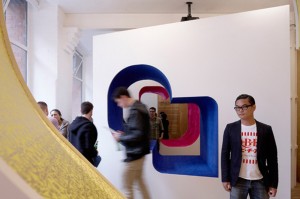
Awarded Bureau Spectacular – Jimenez Lai, Three Little Worlds, 2012. (Photo (c) Daniel Hewitt)
In the past, Triennale organizers have tested two types of strategies for the event: the large-scale venue with national pavilions and a thematic group of exhibitions bound by a theme. In 2007 Urban Voids was presented as an international exhibition in three large pavilions. Initiated by José Mateus, current Triennale president, and with a team of guest Portuguese critics and architects, the event was presented as a polyphonic labyrinth of exhibitions unified under the pavilion architecture and scenography, unfolding nations’ representations, the ‘Europeanization’ of Portuguese architecture, large installations by guest star-architects, such as Zaha Hadid or DillerScofidio+Renfro, among others.
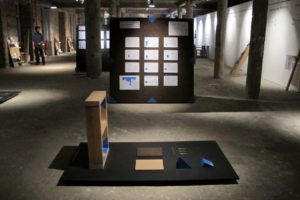
Fabrica instalation at Institute Effect exhibition. (Photo (c) Fabrica)
A second core included urban development projects, as well as a real estate investors’ exhibition, covering all scales and kinds of expectation in face of the Urban Void: from internationalism, to authorship, to investment, to planning. The previous Triennale, in 2010, zoomed in on the question posed by chief curator Delfim Sardo: ‘Let’s talk about houses.’ Thinking of the building and dwelling of a house, an elemental programme for both private and public commissions, it was organized in large autonomous exhibitions, curated by the most influential Portuguese curators. That year, the Triennale was located in Lisbon´s official cultural venues, featuring offices and universities, foreigner and national authors, lined up in clear-cut curatorial projects and instigating competitions, such as a project on housing in Luanda. With experience following enthusiasm, organizers produced these Triennales with great detail and in a stable economic condition. They presented well-established architectural production to a clearly cultural and/or specialized audience.

Fabrica process at Institute Effect exhibition. (Photo (c) Fabrica)
In 2013 the economic bubble burst, Europe changed, construction stopped. This year’s Triennale tackles, in a jovial way, the new contextual conjuncture. Close, Closer’s proposal was selected from the first curatorial competition, in 2011, and is headed by chief curator Beatrice Galilee and a young team aligned around a UK-NY axis: Liam Young, Mariana Pestana, Dani Admiss and José Esparza Chong Cuy. Chief curator Galilee addresses non-tectonic, non-technical, non-representational and non-conventional notions of architecture, diverging from ‘buildings’ and ‘walls’ to less physical spaces. The team instantiates science-fiction (Liam Young), literature and site-specificity (Mariana Pestana), ephemeral interventions (José Esparza), and collective strategies for gathering (Dani Admiss).
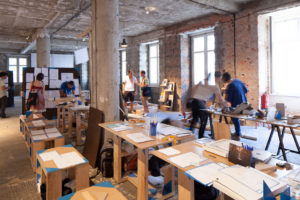
Fabrica workshop at Institute Effect exhibition. (Photo (c) Luke Hayes)
Speech and performativity are the central aspects of the programme, highlighted against the historical backdrop of more formal exhibitions, pavilions or academic encounters of previous editions. Utilising relationality, conversation, happenings and imagination as tools to expand notions of space, the approach is not academic, yet we can sense authors, such as Lefebvre, de Certeau, or Petrescu, transmitted by posture although absent in the discourse.

Future Perfect exhibition at Museu da Electricidade. (Photo (c) Luke Hayes)
The organization has ventured a programme of curated activations interpolating participation. We understand Close, Closer as a diagram of constellations and contiguities: three of its four main exhibitions/programs – Institute Effect (Dani Admiss), The Real and Other fictions (Mariana Pestana), and Civic Stage (José Esparza) – consist of new commissions to organizations/authors/collectives who developed projects. One peculiarity of this year’s Triennale is that in most cases guests unfold their invitations and extend them to other collectives/associations/people (who are not necessarily architects) who bring their experiences, thoughts and expectations, activating a public arena (exhibitions, stages, workshops).

New Publics at Civic Stage. (Photo (c) Miguel Guzman imagensubliminal.com)
The programme of Institute Effect, at Mude, is a clear ‘carte blanche’ invitation to a week-long residency in Lisbon of some of the most influential cultural organizations around interdisciplinary-ephemeral-arty architectural culture: Fabrica (Italy), Storefront to Art and Architecture (NYC), Institut fur Raumexperimente (Berlin), Strelka Institute (Moscow), Spatial Agency (UK), SALT (Turkey), Urban-Think Tank/ETH (Venezuela/CH), Centre for Urban Pedagogy (NYC), Z33 (Belgium), LIGA – espacio para arquitectura (Mexico), Design as Politics (Delft), and the Portuguese architects’ Institute newspaper, Jornal Arquitectos.

Public at Palácio Marquês de Pombal. (Photo (c) Miguel Guzman -imagensubliminal.com)
These ‘institutes’ are invited as a means to boost contact with the ‘constituents’ of Lisbon’s cultural scene through workshops, talks, collective publications, and construction of small objects, for the three months of the Triennale. During the first five days of the event, we could find the set-up and the activation by Fabrica, a modular structure and whole range of bits to allow for the next guest to ‘institute’ their stay, while Storefront refused to be indoors and started a series of discursive meetings outdoors, in public spaces.
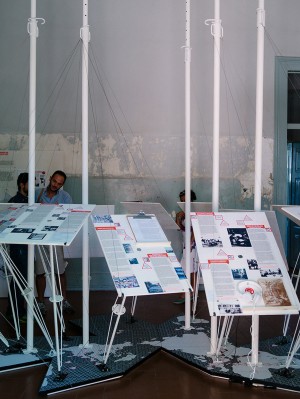
Radical Pedagogies Exhibition by Princeton School of Architecture Associated Project. (Photo (c) Miguel Guzman imagensubliminal.com)
In close relation to history and to a specific building, the 17th century Palace of Marquês de Pombal, Mariana Pestana researches the history and evolution of the building and shares her knowledge, leading us through space. During a tour of re-enactments of the several uses that the palace had for 250 years, visitors listen to fictional stories of the Palace (Maria Fusco), participate in civic assemblies on Urban Rights (Zuloark), may take part in exquisite meals (The Centre for Genomic Gastronomy) and on its program of conversations, present their nowhere lands and hidden states at a fictional embassy (Paulo Moreira & Kiluanji Kia Henda), and are invited to a written conversation with starchitects, cultural agents, and other architecture-related actors in a new on-going fanzine (Friendly Fire). The exhibition comes closer to history and explores fiction and storytelling, expanding on traditional research.
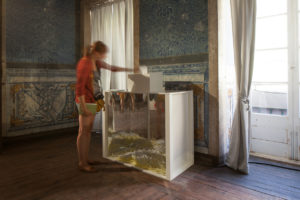
Sala da Naço Embaixada de Terra Nenhuma at The Real and Other Fictions exhibitions, by Paulo Moreira & Kiluanji Kia Henda. (Photo (c) Luke Hayes)
At New Publics, José Esparza stages at Frida Escobedo´s Civic Stage (tortilla-shaped platform used as an arena for the public or as a stage for performers) several actions and speeches by artists/architects/collectives (from Pelin Tan, to Francisca Benitez, to Unipop, Artéria, to many others), interpolating the passers-by of Praça Figueira. Access by the general public was better resolved in the evening: The Super Powers of Ten (Andrés Jaque /Office for Political Innovation), a disassemblage of the educational film by Charles and Ray Eames, presented in a smartly layered show, entertaining, targeting all audiences and including passers-by as the backstage. Everyday activations of the stage beyond more codified public/stage relations, such as these, are difficult to achieve.
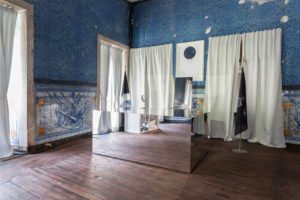
Sala da Naço – Embaixada de Terra Nenhuma, at the Real and Other Fictions exhibition by Paulo Moreira & Kiluanji Kia Henda. (Photo (c) Catarina Botelho)
The Future Perfect exhibition, at Electricity Museum, is more distant from the social, the local and the relational, as it bets on science fiction and other possible futures, to propose dystopic (thought to be optimistic) technological futures. Expanding along scientific laboratorial research the notions of space, landscape and the tools for illustration and invention of space, the exhibition takes us elsewhere. The video Chupan Chupai, by Factory Fifteen, is its best, mingling the adult, infant, non-English language, the real, and virtual, to produce a speculative, yet highly realistic, new future space.

Sonda Espacial L.Q.F.U.B. at The Real and Other Fictions exhibition by Friendly Fire. (Photo (c) Catarina Botelho)
The Triennale lacks clearer understanding of ‘non-buildings’. Is it a conceptual/theoretical choice, an act of political resistance, or a consequence of economic contingency? When conceptual spatial practices were highlighted back in the 2008 Venice Architecture Biennale, a mainstream event showcased ‘alternative’ architectures as Out there: Architecture Beyond Building was interrupted by a historical coincidence, the financial crisis. Although the Biennale began as a showcase, it soon overlapped temporally with the financial/real estate crisis. Unexpectedly, casting conceptual and critical alternatives to real estate architecture, it was a twin premonition of what would come: scarcity and insolvency of building came before the end of the Biennale. This interlude allows us to get back to Lisbon with a different awareness as we sense the Triennale coming into shape with perhaps a kinder of twist of fate. But is it more than a contextual circumstance?
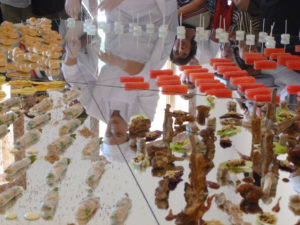
The Center for Genomic Gastronomy at The Real and Other Fictions exhibition. (Photo (c) Ines Moreira)
The vertiginous crisis and collapse of building business/industry changed the priorities and the chess boards, quickly causing young architects to reinvent their future endeavours. Moving away from corporate building, and sometimes with results closer to more conceptual practices (as those of Vito Acconci, to Didier Faustino, Recetas Urbanas, or Pedro Bandeira), small scale interventions/ephemeral spaces, field work practices, or participatory projects have emerged as an alternative to the economic context.

The Civic Swing at Civic Stage – New Publics. (Photo (c) José Esparza)
Not necessarily affirmed by disciplinary negation of the act and the facts of building, nor oriented by clear theoretical positions, we attempt an interpretation. Expanding on the quite generic title, ‘Close, Closer’: as offices ‘close’ doors, practitioners go ‘closer’ to their potential public, and turn to ‘making do’. Very young practices go ‘far away’ from canonically defined ‘architecture’, as well as ‘far away’ from ‘architectural critique’, and find their way through the making.
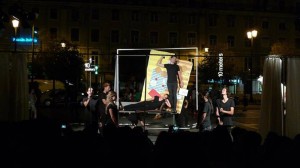
The Super Powers of Ten, by Andrés Jaque – Office for Political Innovation. (Photo (c) Luis Tavares Pereira)
The responses to the open call for projects faced this reality, with a considerable number of proposals: Associated Projects, embracing 90 projects out of 160; the Debut prize competition had 188 applications – and was awarded to Chicago based Bureau Spectacular, run by Jimenez Lai. Individually diverse, the multitude of less object-oriented productions unfolds ever more productions and collaborations. ‘Oh, my God, this is not a niche programme, this is not alternative architecture, this is a mainstream and popular programme’, stated Beatrice Galillee. The echoes still resonate.
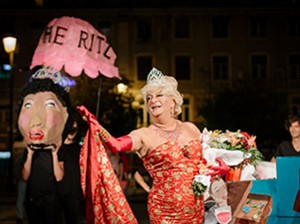
The Super Powers of Ten by Andrés Jaque – Office for Political Innovation. (Photo (c) Miguel Guzman imagensubliminal.com)
Some of the most interesting practices present in the open call bring participation into the political realm. In line with SAAL, the Portuguese revolutionary movement of the 1970s, which is as old as these new practitioners, some practices activated the self-construction of designed housing in impoverished workers´ neighbourhoods (briefly featured in Radical Pedagogies associated exhibition). These included: Artéria´s Edifício Manifesto and Agulha num Palheiro (Lisbon), EXYZT + partners Casa do Vapor (Almada), Pedro Campos Costa + students (Almada), Gargantua Collective (Lisbon), and the non-architects of Associação Cultural O Moinho da Juventude (Lisbon). They brought to the fore the complex, violent and deprived contexts away from Lisbon’s centre, in the suburbs or in brownfields. These projects and sites are places for social and political action, diverging from a stage, a fiction, or a relational platform.

Urban Parliament, Universal Declaration of Urban Rights, by Zuloark at The Real and Other Fictions. (Photo (c) Zuloark)
One of the urges of Triennale seems to be participation: why, what, for whom? The mentioned architects are taking part in the social, and the political, exploring new economic alternatives, and this may be questioned by conservative ideas of practice, and of research. If we accept the call and the idea that Close, Closer is a sort of communication device, we must consider inter-generationality, friction and eventual antagonism, or at least negotiation as tactics of inclusion, from inhabitants, to citizens, to different opinions on the proposed curatorial concept.
As stated in a Portuguese newspaper, Beatrice Galilee claims a separation from established and successful old generations which she refers to as ‘white, successful men’ (today in a not so solid situation) declaring publicly in Lisbon a generational issue. Within these lines, participation occurs, but inclusion nonetheless becomes exclusion.
In his book for the Biennale de Lyon by editor-architect-curator Markus Miessen – The violence of participation (2007) – we are reminded of the need to continuous negotiation and strategic encounters as part of participation, beyond conversationality or relationality.
The participatory and non-objectual Manifesto behind the 2013 Triennale’s global proposal is vague, and although some exhibitions are interesting and offer a platform to gather for three months, the reality of the encounters is somehow cut short. Issues between generations are only superficially touched, showing little awareness, as present day generations are asking for very complex answers. The uncertainties of a disenchanted class of young professionals who grew in a shrinking counter-cycle, population still (!) having no access to proper housing, or to infrastructure, the need to renew tools for practice, building, and funding, seem the non-addressed questions of the generation represented. After the first five days, we feel that deeper socio-political questions need more maturity in their articulation, especially in face of this ‘coming community’. But, with disagreement and antagonism kept afar, participation becomes consensus.
We believe that 2013 Lisbon Architectural Triennale is a fissure in the status quo, but it’s hard to see where the crack goes. ‘Close, Closer is a moment for the production of knowledge and the distribution of ideas. It is an ongoing conversation between histories and futures, and the creation of a space for ideas and ambitions’ (Galilee). The device is set to interpolate us all (if we wish) and we expect a burst of speech for the next three months.
The Triennale is ‘post-something’: post-bubble, post-formal, post-closure, post-building, post-disciplinary, or all at the same time. Though, one important task for the event until its finish in December will be to collect the burst of activity and statements, i.e. to amass the declarations, manifestos, ideas and all sort of proposals left by the public and the under-35 generation in the many interfaces prepared to receive it during the festival. Beyond the festival, it is fundamental to conceive proper learning from the devices already set in action. Contemporary Southern-European architecture (or architects in Lisbon or in Portugal) is in need of an articulation of this ‘post-crisis’ condition and its alternatives, requiring proposals for the present and the near future. The next three months are an opportunity to see, be part, discuss, write, agree, and disagree, and the Lisbon Triennale merits a visit. Its call is to participate, and its need is to edit the burst of presented ideas.
Inês Moreira (1977) is an architect, researcher and curator based in Portugal. In 2013, she is completing her PhD, an epistemological and process-oriented research on the issues of curating architecture, space and exhibition display, presented under the title ‘Performing Building Sites, a curatorial research on space’, developed at Curatorial/Knowledge PhD group, Goldsmiths College. Her curatorial projects approach specific spaces (as post-industrial hangars, burnt historical buildings, minor architectures, or abandoned museums) exploring knowledge oriented research/production in the intersection of art, architecture, techno-science and the humanities. Related sites are facebook.com/inexmoreira and www.petitcabanon.org.